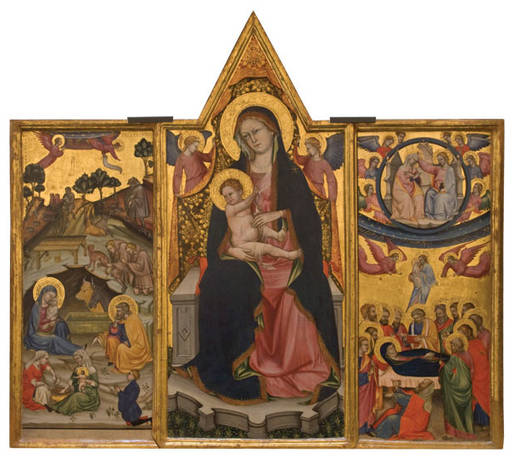


Today, in the United States, this masterpiece somehow symbolizes the immense cultural heritage of Abruzzo that needs to be saved after the earthquake last year. The triptych, after its exhibition at the National Gallery of Art [2] in Washington, where it was admired by more than 300 thousand visitors, is now at the Museum of Art di Reno [3], Nevada.
There was no information on the Triptych of the artist of Beffi except the fact that it came from the L’Aquila museum.
To understand better its history, we wanted to go in search of the monastery of Santa Maria del Ponte, for which the work was conceived.
The ancient monastery at 30 km from L'Aquila, heading Sulmona, in the area of Tione degli Abruzzi, near the river Aterno, still stands near an isolated small and charming fortified village which took its denomination from the monastery. We are in the heart of Abruzzo, in the Sirente Velino Park.
The monastery was mentioned for the first time in a document dating back to 1138. During the following centuries, in the village were built the churches of St. Lucia and S. Pancrazio. The ancient curtain walls, still quite well preserved, show two beautiful ogival portals.
The monastery church of St. Maria del Ponte (or S. Maria Assunta), situated at only some tens of meters from the village, seems to be built by Equizian monks during the 12th Century on the rests of a 5th-6th Century pagan temple. Later it became a Benedictine monastery, because the Equizians were absorbed by the Benedictine Order. Other authoritative historians date the building even back to 1000.
The initial, supposedly aisleless plan became a nave with two aisles in the course of a radical conversion, carried through in the 14th Century. The reason for this gradual extension of the construction from the 14th Century on, is the growing population in both villages: Santa Maria del Ponte and Tione.
The Church of St. Maria del Ponte has been damaged by the earthquake in several parts, especially the annexed ones, and was condemned. With loving care, the members of the homonymous Cultural Association have patiently collected and preserved the fallen off pieces, hoping that in the near future could be found the necessary resources for the restoration of this splendid testimony of the religious architecture of Abruzzo.
We enter with caution and emotion. The church, usually closed like so many ancient solitary churches in Abruzzo, appears bare compared to its riches of past times, and yet still incredibly interesting.
“The understanding of a art work” – supports Fabiana Di Tullio, the expert of cultural heritage who attends us – “it does not end with a visit to a museum, but requires local knowledge and the context which the art work was designed”. Still consecrated, the building consists in a nave (S. Sisto Chapel) ending in an apse with three Gothic windows, the left aisle (St. Agatha Chapel) and the one arch right aisle (S. Joseph Chapel). Contiguous to the right aisle there is the Confraternity Oratory with frescoes of the 18th Century. The aedicule-shaped baptistery has a lancet arch.
The portal of the Romanesque-Gothic façade is characterized by an archivolt with a fresco of the 14th Century depicting the Virgin. The wall above the apse is decorated with a huge fresco depicting the Crucifixion.
On the walls there are rather damaged fragments of frescos. At the front of the altar we see an almost illegible inscription with the date of 1333. This indicates one of the flourishing artistic periods due to which the church could take on monumental importance.
The symbolic lamb carved in low relief next to the inscription reproduces the same iconography similar depictions existing on portals in L’Aquila.
For centuries, the Triptych with its large coffered roof was located upside the main altar of the Church of Santa Maria del Ponte dominating the small 13th C. apse. From there it was removed for safety reasons and preservation after the earthquake of 1915, and subsequently exhibited at the Museo Nazionale d'Abruzzo. Since the beginning of the 20th Century the whole area experienced a gradual decline due to the crisis in pastoral economy and the resulting migration process.
The Triptych is a splendid work of the early 15th Century, created by an artist from Beffi. The unknown painter worked in the Valley Subequana and L’Aquila between the end the 14th Century and 1520. He has created several other works including the frescoes in the churches of S. Sylvester in L'Aquila and S. John the Baptist in Celano, but he was named after the Triptych which is his masterpiece. Also the sculpture “Tree of the cross” or “Tree of the seven words” (exposed in the National Museum in L’Aquila), for its similar characteristics to the S. Sylvester frescoes, is attributed to the so-called “Artist of the Beffi Triptych “.
The anonymous painter might have been a follower of Taddeo di Bartolo (1362/1363-1422) or other painters from or working in Abruzzo including Andrea De Litio, famous for the frescoes of the Atri Cathedral.
Beffi – after which the artist was named - it is a tiny medieval village, today a suburb of Acciano, at only three kilometers from the Church of St. Maria del Ponte.
We are going around in the quiet solitude of the small village which, even though it resisted the earthquake impact, now appears almost abandoned. The earthquake has struck again Abruzzo, devastating L'Aquila and destroying dozens of neighboring villages, also inside the Sirente-Velino Park, an incomparably beautiful landscape, surprisingly rich in art monuments and historical heritage.
The Triptych will be exhibited at the Nevada Museum of Art until 11 April and ends its U.S. tour at the Getty Museum [4]di Los Angeles. But there could be more exhibitions in the future.
Source URL: http://test.iitaly.org/magazine/focus/art-culture/article/travel-ancient-trail-beffi-triptych
Links
[1] http://test.iitaly.org/files/13474trittico1267798684jpg
[2] http://www.nga.gov/exhibitions/beffiinfo.shtm
[3] http://www.nevadaart.org/exhibitions/detail?eid=159
[4] http://www.getty.edu